#Menstrie Castle
Explore tagged Tumblr posts
Text




December 13th 1585 saw the birth of William Drummond of Hawthornden, the noted Scottish poet.
Drummond was born at Hawthornden Castle, near Bonnyrigg, Midlothian, the eldest son of Sir John Drummond, Laird of Hawthornden. The Drummonds were an ancient family with connections to the Royal House of Stewart. Drummond was educated at the High School of Edinburgh, then at Edinburgh University, graduating MA in 1605. From 1606 to 1608 he studied Law in Paris and Bourges. When he returned to Scotland in November 1608, he bought back nearly 400 volumes of French, Italian, Spanish, and English literature, the foundation of a fine private library. In 1610, Drummond visited London, meeting some of the most famous poets of the city. Upon his father’s death later that year, Drummond became Laird of Hawthornden and retired to the family seat, to write and to lead a life of "gentlemanly simplicity". It's alright if you have the money eh!
Drummond has long enjoyed a reputation as Scotland’s foremost seventeenth-century poet. He wrote in English, not Scots, and is regarded as playing a major role in the Anglification of Scottish literature. As his poetic reputation grew, he began to correspond with the Scottish poets at the Court of King James VI and I: Robert Kerr, Sir Robert Aytoun, Sir David Murray, and, particularly, William Alexander of Menstrie.
When James VI made his only return to Scotland in 1617, Drummond saluted him with Forth Feasting: A Panegyricke to the Kings Most Excellent Majestie. This led to Drummond’s work becoming more widely known in London literary circles. Ben Jonson, on a visit to Scotland, stayed at Hawthornden Castle in 1618, and Drummond recorded their conversations. In 1623, Drummond was deeply affected by the loss of his mother and the death of many friends in a famine that afflicted Scotland. His grief was expressed in his next volume Flowres of Sion, a collection of religious and philosophical lyrics.
In 1626, Drummond was made a burgess of Edinburgh and in the same year made a major donation of books to Edinburgh University Library. His gift of around 550 volumes made him the Library's first significant private benefactor and gave the Library it's first literary collection. Drummond made further donations on an annual basis between 1628 and 1636. All in all, he presented some 800 printed titles and thirty-six manuscripts; around 700 volumes survive in the Library’s collection. These include some of the Library's greatest treasures, especially in the fields of literature, history, geography, philosophy and theology, science, medicine and law. They include early printings of Shakespeare, Jonson, Spenser, Drayton and Sir Philip Sidney, a complete copy of John Derrick's Image of Irelande from 1581!
By 1633, Drummond had resumed his literary career, writing a series of pageants for the Scottish coronation of Charles I. From the mid-1630s onwards, however, Drummond’s energies turned to political pamphleteering. His first overly political work was a defence of John Elphinstone, Lord Balmerino, who was convicted on a capital charge of libel against the King for possessing a document thought to be treasonable.
He also got involved with The National Covenant, although opposed to the infamous prayer book, rather than the taking of arms which blighted Scottish history he advocated passive obedience to the King. Further pamphlets attacked the Presbyterian grip on the country and warned of the consequences of civil war.
Drummond played no personal role in the Bishops’ Wars of 1639 and 1640, and in the civil conflicts that rocked England and Scotland over the following decade. His last substantial tract was Skiamachia, or, A Defence of a Petition in 1643, in which he assumed an extreme anti-clerical position.
Drummond died at Hawthornden Castle on 4 December 1649. Drummond’s son William and brother-in-law collaborated the posthumous printing of much of Drummond’s work.
The wooded solitude Drummond enjoyed at Hawthornden still exists to this day and is an international retreat for writers at Hawthornden Castle has been founded to provide a peaceful setting where creative writers can work without disturbance. To me though, below the cliff it sits on above the River Esk, is the interesting bit, Wallace's Cave, a large rock cavern with a neatly chiseled doorway said to be where our favourite Freedom fighter used at the time of the Battle of Roslin, which took place nearby in 1303.
9 notes
·
View notes
Text
Menstrie is a charming village nestled in the shadow of the Ochil Hills in Clackmannanshire, Scotland, has a strong tradition of craftsmanship, particularly in the field of joinery. Professional joiners in Menstrie are known for their exceptional skill, blending traditional techniques with modern innovations to create bespoke wooden structures and fittings that are both functional and aesthetically pleasing. This trade is an integral part of the village’s economy, contributing to the maintenance of its historical character while also meeting the needs of contemporary living.
Joiners in Menstrie: Architectural Heritage
Joinery has long been a crucial part of Menstrie’s architectural identity. The village’s buildings, ranging from historic homes to modern developments, often feature intricate woodwork that reflects the high standards of craftsmanship in the area. Professional joiners have been responsible for much of this work, applying their skills to everything from the restoration of old buildings to the construction of new, energy-efficient homes.
Menstrie Castle, a prominent historical landmark in the village, is a testament to the enduring legacy of joinery in the area. The castle, built in the 16th century, has undergone several restorations over the years, with local joiners playing a vital role in preserving its wooden features, including beams, staircases, and window frames. These craftsmen have ensured that the castle’s historical integrity is maintained while also adapting it to modern standards of comfort and safety.
Skills and Techniques of Professional Joiners
The joiners of Menstrie are highly skilled artisans who bring a wealth of knowledge to their craft. Traditional joinery techniques, such as dovetail joints, mortise and tenon, and hand-carved details, are still widely used by these professionals. These methods have been passed down through generations, ensuring that the quality of work remains consistently high. The emphasis on precision and attention to detail is a hallmark of Menstrie’s joiners, who take pride in producing work that stands the test of time.
In recent years, the profession has also embraced modern technologies and materials. Joiners now use advanced tools such as CNC (Computer Numerical Control) machines, which allow for precise cutting and shaping of wood. These machines, combined with traditional hand tools, enable joiners to produce intricate designs and ensure a perfect fit for every piece they create. Additionally, the use of sustainable and eco-friendly materials has become increasingly important, reflecting a broader shift towards environmentally responsible construction practices.
Services Provided by Joiners in Menstrie
Professional joiners in Menstrie offer a wide range of services, catering to both residential and commercial clients. These services include:
1. Custom Joinery: Many joiners specialise in creating bespoke pieces tailored to the specific needs and preferences of their clients. This can include anything from custom-built furniture and cabinetry to tailored storage solutions and decorative woodwork.
2. Restoration and Conservation: Given Menstrie’s historical significance, there is a strong demand for joiners skilled in restoration work. These professionals are adept at working on heritage buildings, carefully restoring or replicating original wooden features to preserve the character and history of the property.
3. New Builds and Extensions: Joiners in Menstrie are also involved in the construction of new homes and extensions. Their expertise ensures that all wooden components, such as staircases, doors, windows, and flooring, are crafted to the highest standards and seamlessly integrated into the overall design of the building.
4. Outdoor Structures: Many joiners also specialise in creating outdoor wooden structures, such as decking, pergolas, garden sheds, and fencing. These projects require a deep understanding of wood’s durability and how it can be treated to withstand the elements, ensuring long-lasting and attractive outdoor spaces.
5. Commercial Projects: In addition to residential work, joiners in Menstrie also take on commercial projects, such as fitting out shops, offices, and restaurants. This work often involves creating custom interiors that reflect the brand and identity of the business, combining functionality with a distinctive aesthetic.
Challenges and Opportunities
The joinery profession in Menstrie, like many traditional trades, faces several challenges. One of the most significant is the shortage of skilled workers. As older joiners retire, there is a growing need for younger professionals to enter the trade. Local apprenticeship programmes and training initiatives are essential in addressing this issue, providing the next generation with the skills and knowledge needed to continue Menstrie’s rich joinery tradition.
Another challenge is the increasing demand for sustainable construction practices. As clients become more environmentally conscious, there is a growing need for joiners to source sustainable materials and adopt eco-friendly practices. This shift presents an opportunity for joiners to differentiate themselves by offering green solutions that appeal to this emerging market.
Conclusion
Professional joiners in Menstrie, Clackmannanshire, are more than just skilled tradespeople; they are custodians of a craft that is deeply embedded in the village’s history and culture. Their work, whether in restoring historical landmarks or creating modern living spaces, reflects a commitment to quality and tradition that continues to define Menstrie’s architectural landscape. As they adapt to new technologies and sustainability demands, these craftsmen will undoubtedly continue to play a vital role in shaping the future of the village, ensuring that Menstrie remains a place where craftsmanship and heritage are valued and preserved.


0 notes
Text
Broomhall Castle




Broomhall Castle is located in the county of Clackmannanshire in Menstrie village, Scotland. The Baronial castle was built in 1874 for James Johnstone. The three-story castle has a tower and was used as Johnstone’s private residence until his businesses fell into decline. The castle was sold to the Italian Riding School in 1906. In 1910, the Castle was sold to the Clifford Park Boys Prep School, with 10 boarders. The castle suffered through fire in 1941. The roof fell in and the building was gutted. Thankfully the German Schoolmaster had taken the boys out of the castle for a midnight feast when the fire occurred. Unfortunately, the fire allowed German planes to bomb the Clyde shipyards, and to safely fly away across the Ochil Hills. I’m unsure if this attack was planned in part by the German Schoolmaster, but it definitely sounds like a possibility. Broomhall Castle became a ruin until 1985 when it was rebuilt into a nursing home. In 2003, the castle was converted into a hotel with 16 en-suite bedrooms, a restaurant, and a lounge.
3 notes
·
View notes
Text
Our first view of Broomhall Castle was as a yellow light floating in the distance.
We’d rented a car from Glasgow Airport and driven down in M8 through the growing twilight. By the time we reached Stirling it was pitch black and foggy. We’d passed through un-countable roundabouts, been honked at by an angry Scotsman, and were starting to think we wouldn’t last the night.
Then we turned the corner of yet another roundabout, and through a gap in the trees we could see a vast array of lights. At last! Proof of civilisation. We surveyed the vista, and asked, “I wonder what that is over there.” We soon found out… it’s our new home! For the next three days at least…
Broomhall Castle
The main, absolute, fundamental selling point of this hotel is simple: it’s a castle. Admittedly, not a *real* castle: it was built in the late 19th century, not the 15th; and it hasn’t even a moat or turrets. But it’s still a castle, with towers, on a hill, that backs onto an awesome moor, in Scotland. It was perfect (and relatively reasonably priced).
I also really liked the decor: simple, pleasant, not too swishy. All the other hotels in the area seemed very modern, with glass things and silky purple walls. That isn’t my aesthetic at all! Everything at Broomhall Castle was wooden and homely and traditional. It also had one of the biggest baths I’ve ever seen in a hotel, which was amazing after a long day walking up a Scottish hill.
Location
We were in the area for two reasons: to walk up a hill; and to visit Stirling Castle. Broomhall Castle was very well positioned for our walk – it’s in a village called Menstrie, which had a perfectly located footpath running up into the hills behind. Unfortunately, being in a little village, it wasn’t so well located for Stirling. If we hadn’t had a car, we would have had to get a taxi or the bus. This probably wouldn’t have been a huge problem, but it certainly wasn’t as convenient as being in Stirling itself.
To be honest, even having a car wasn’t ideal. There was so many roundabouts, it felt like it took twice as long to get everywhere, especially driving a manual! Also, it meant that we couldn’t drink at dinner when we ate out. This, and the fact at it got so dark so quickly, meant we were very tempted just to eat in the hotel all the time.
Food
Breakfast was included, and that was awesome. I had a full cooked breakfast every day: sausage, bacon, beans, tomato, toast, mushroom, and a strange potato bread thing. I also could have had haggis and black pudding, which is very Scottish. It was delicious – perhaps not very good for my arteries but hey, we did a lot of walking!
I also could have had ‘traditional Scottish porridge’. However, we suspected that it would be made with water and be salty – unlike our usual English porridge, which is made with milk and sugar. I wanted to ask how ‘traditional’ the porridge was, but I was so nervous that they would think I was a wet, soft Englishperson when I inevitably declined their tough, hardened Scottish porridge that I never got up the courage.
Dinner was delicious, if a bit odd. The starters were awesome: I had sweet potato soup on the first night and seafood chowder on the second. They both came with huge chunks of this soft, seeded, herby bread which I really enjoyed.
For mains, on the first night I had venison in a raspberry sauce. It was a strange combination, but quite pleasant by the end. I’ve never had venison before, but it seemed well cooked and tender. On the second night I had a lovely steak, perfectly cooked, which came with ‘haggis bon bons’ – i.e., deep fried breaded haggis balls. Very strange, not entirely necessary, but fine.
I also had a white chocolate cheesecake, which was huge and a little heavy – but then again, I still ate every crumb!
Staff
The people who work at Broomhall Castle were easily the stand-out part of the trip. Very friendly and welcoming, but also professional – the perfect balance. A special shout out is needed for Scott, who carried out suitcases up the stairs as if they were filled with feathers, not heavy boots. I also very much appreciated the hot chocolate Gary heroically made for me: it may have taken several tries but in the end it was delicious and silky smooth.
Overall, I’m so glad that we chose to stay at Broomhall Castle. It suited us perfectly, and made our trip to Stirling so easy and special.
Our first view of Broomhall Castle was as a yellow light floating in the distance... Our first view of Broomhall Castle was as a yellow light floating in the distance. We'd rented a car from Glasgow Airport and driven down in M8 through the growing twilight.
0 notes
Text
Dumyat sunrise - a big wee hill
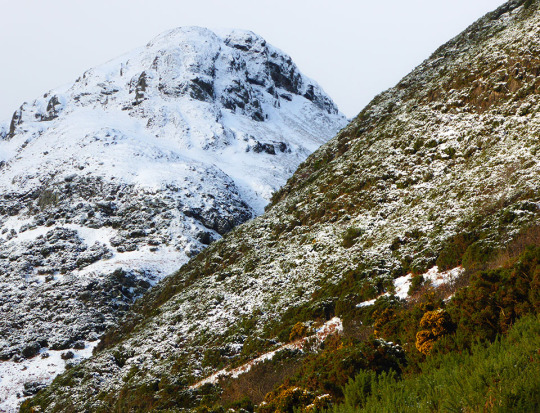
It’s difficult being English in Scotland, but not for the reasons you might think. I’ll put it on record now that in the 14 years since I moved north I have experienced nothing but generosity and friendliness from my adopted countrymen. Scotland has been welcoming and has invited as much or as little naturalisation as I felt comfortable with. This is my home now, if it’s not too corny to say so it is where my soul fits best. I know this where I belong. And yet in those early years, try as I might the one thing that repeatedly hindered my willing naturalisation were the place names and language.
Dumyat, a rocky knoll overlooking Stirling was my first serious linguistic obstacle and the hill that made me realise it would take a while to settle in to my new home. For the first few months I didn’t really know anyone locally, and certainly didn’t know any hillwalking type folk, so I merrily hiked my way around the munros in blissful ignorance of the correct way of saying things. But then one day I found myself in the company of an Edinburgh local who had been climbing hills all his life.
‘Where are you off to this weekend’, he asked.
‘Ben Ledi I think’, which was said correctly as ‘Leddy’. There wasn’t really much room for error there.
‘But’ I continued...’that probably won’t take all day though, so I think I’ll stop at Dum Yat on the way home’.
‘Where?’
‘Dum YAT. It’s a small hill near Stirling’.
Cue much laughter and ridicule.
‘It’s not Dum YAT, you arse, it’s ‘Dum-EYE-at’.
‘Well how was I supposed to know!?’ I protested.
Bear in mind we didn’t have the wealth of easily accessible information back in those dusty olden days. There wasn’t YouTube. There was barely internet. I mostly relied on books, and they didn’t write hill names out phonetically because they were written for a local audience who already knew how to pronounce these things.
After that I think I pretty much shied away from pronouncing anything in public. Over time it got easier of course, not least because websites started springing up that actually spoke these names aloud to you. True, some contradicted one another, but at least it gave you something to work with. And so I continued my walking around Scotland, thereafter relishing rather than fearing place names as every new encounter only broadened my experience of the culture and the landscape.
But I never again returned to Dumyat. That wasn’t a conscious decision on my part, I just never thought about returning. Now though, it amuses me to think that I have perhaps had a subconscious coping mechanism that has steered me clear of that inoffensive wee lump, lest it dig up traumatic memories. Did I have Dum Yat demons to banish? But then in mid January this year the weather gods heaped the lion’s share of limited snowfall onto Stirling and Dunblane. I of course am attracted to wherever the snow lies deepest and so at 8am, nearly 14 years after my first and only visit I found myself in Blairlogie, at the foot of Dumyat.
Dumyat is small really. At a mere 418m it is even smaller than my local hill, East Lomond, and with a handy car park at around 200m altitude its modest summit can be attained relatively easily and in quick time. But approaching from that point, from the high road to the west, denies you the drama of the sheer escarpment to the south.....hence my approach from the Blairlogie car park just outside Menstrie.
I’d not taken this route before but I thought it would be a good choice to see the sunrise across the Forth Valley. And indeed it was!
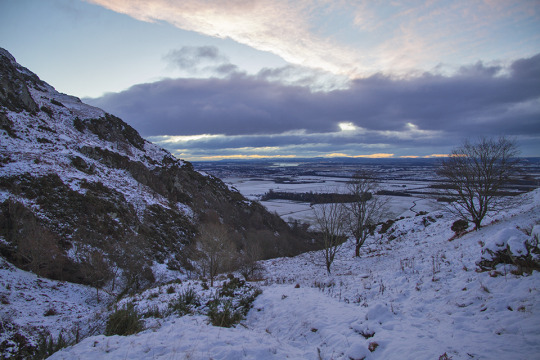
I was gaining height quickly and was already high up on the hill before the first blinding rays of light heralded the dawn. As has been the case most of these past few months, it was clear that the best of the sunrise would pass very quickly owing to the small gap between the horizon and the low cloud hugging the landscape. But even though I was expecting it to be fleeting, the speed with which it passed caught me off guard.
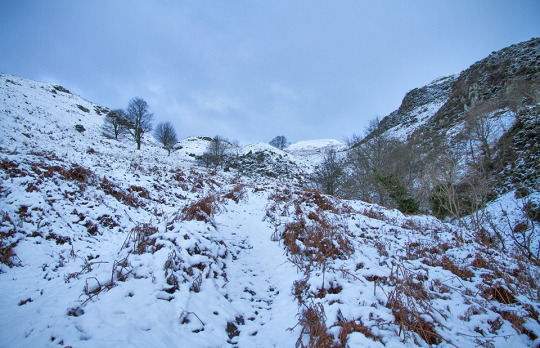
Glancing west, the hills were suddenly burning pink with the glorious alpenglow, but I wasn’t in a good vantage point to get the best view. A large crag was in my way. By the time I hurried 100m or so up the hill to get into a better position the pink was already fading. The below photo, showing the Wallace Monument and Stirling Castle behind it looks vivid but it’s nothing compared to what it was just 20 seconds earlier. It’s incredible how brief these spectacular moments can be.

Never the less, I was chuffed. It’s all very well forming a plan in your head about where you plan to be at a given time and imagining what you are going to see, but all manner of variables outwith your control can scupper your efforts. It’s immensely satisfying when it all works out, even if it is for only two minutes. But truth be told it’s difficult to be disappointed by the views on offer at Dumyat. Though small, its location at the end of the Ochils and immediately overlooking the remarkable Ochil fault that rises sheer from the flat plains below, means it has one of the finest views in all of Scotland. Industrial and urban perhaps, but given that most of the Scottish population lives in this narrow ribbon of land between the topographical highlands and the southern uplands, it’s a view most of us can relate to in some way.
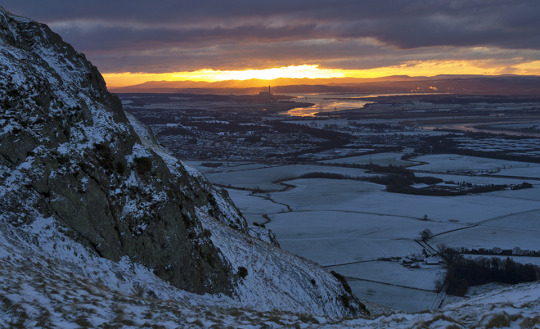
Though the alpenglow had gone, the view out across the Forth Valley was spectacular. The outline of the Pentland Hills, on the other side of the Forth, was aflame.
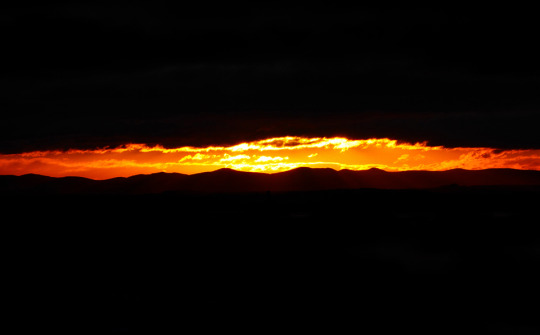
Looking farther east the low light cast familiar landmarks in stark relief: Arthur’s Seat, Edinburgh Castle and the cranes atop the new Queensferry Crossing. And in the foreground the landscape got progressively snowier to the west.

While the view south is industrial, the views west and north are anything but. Capped with snow and the first to catch the morning light, the southern highlands, with Ben Lomond lording it over the flatter parts of Stirling:

By this point I’d veered away from joining the main path that runs east from the high road to the summit, instead relishing the snaking sheep tracks that wound their way under the imposing crags.
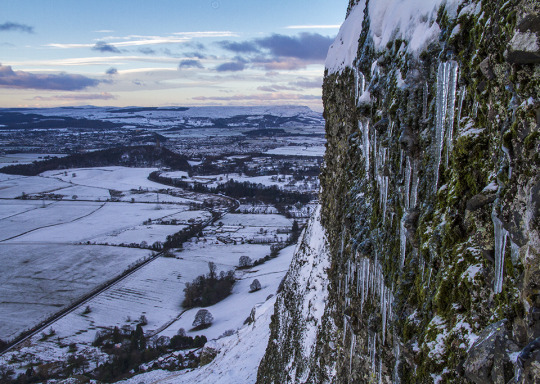
The snow was deeper here too, scoured from higher ground by the wind and deposited in deep but soft drifts. It took a while to negotiate my way past the crags but eventually I crested a rise and found myself at the summit of Castle Law - a 374m subsidiary top of Dumyat and which offers a more tantalising view of the Ochil fault.
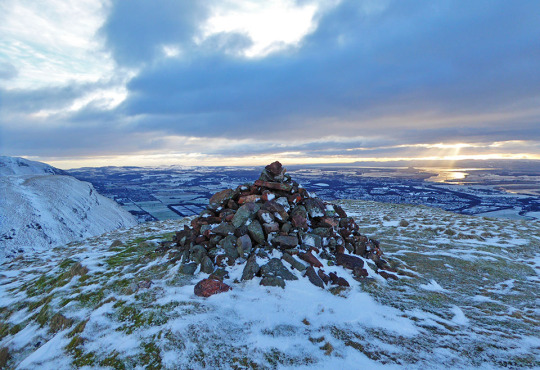
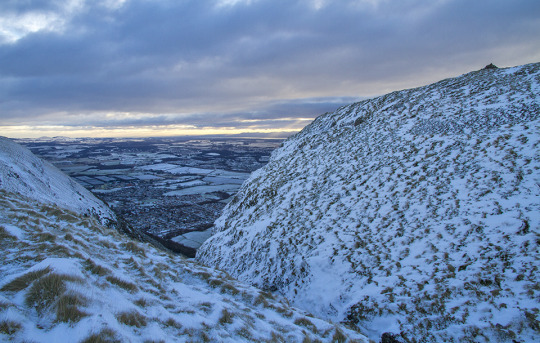
Away and to my left, I could make out the summit trig point on Dumyat, which presented a craggy aspect to be negotiated.
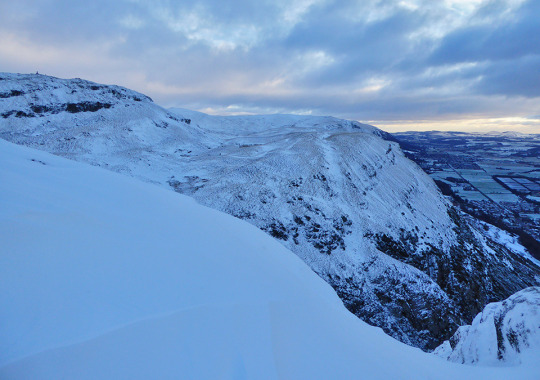
There was no sign of anyone. There were no footprints.
I headed north, away from Castle Law and waded through the intermittently deep snow that had accumulated on any southern aspects.
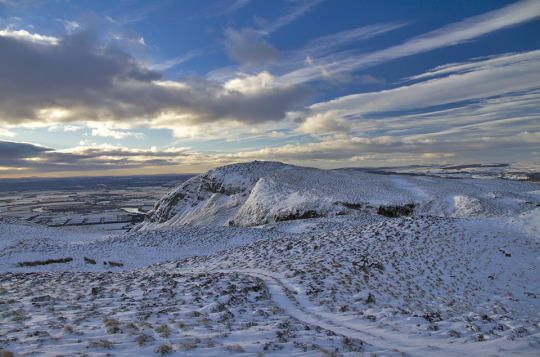
An hour had passed since sunrise, and the sun was now starting to peek over the low cloud for the first time. Though it was early and cold, not far off the shortest day of the year, I could feel the sun’s warmth through my jacket.
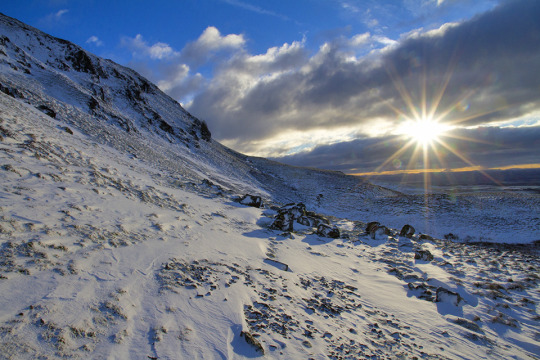
Pressing on, I weaved my way up through the crags under steadily bluer skies:

A fell runner sauntered along the ridge line as I approached, but she was long gone by the time I reached the final approach to the summit:

And then there I was, atop this wee hill but with a view that was anything but!

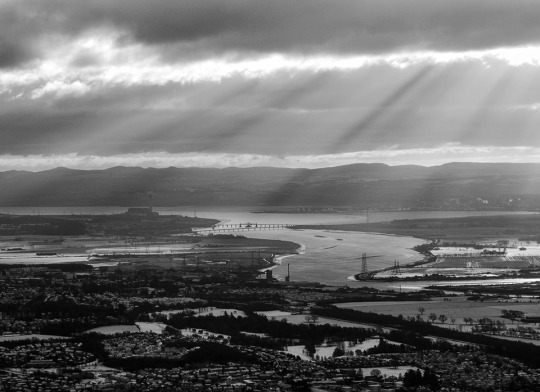
I’d taken such a convoluted route to the summit and with so many stops for photographs that it had taken me well over two hours to get here from Blairlogie. But the journey itself was every bit the equal of the summit reward, although weirdly I had absolutely no recollection of the massive beacon full of stones that topped the summit. It made for a wonderfully photogenic subject though!
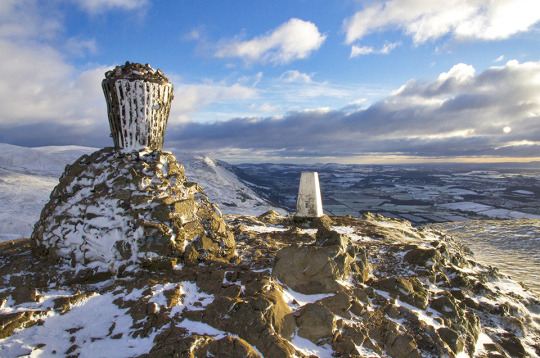
Away to the west, other outdoorsy folk were valiantly making their way up through the snow:

Back at the summit, with a keen wind it was savagely cold so I didn’t hang about, and instead started making my way down the sun-kissed slopes.

I chose a different descent route from the one I used to ascend, which took me east into Menstrie Glen:

It was an easy and quick descent in the snow, and before long I was on the high level path that skirts around the southern flanks of Dumyat and takes you back to Blairlogie. The contouring path offered great views back up the craggy summit:
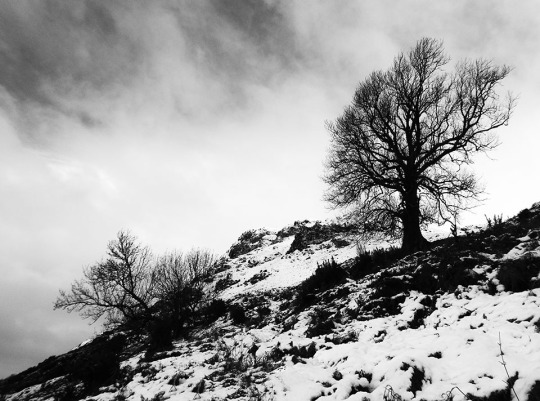
And wonderful views across to the Wallace Monument:

Perhaps even more impressive, however, was the massive craggy face of Castle Law, the outlying notch on which I’d stood not 90 minutes earlier. In its winter garb and with little to judge scale, it looked positively highland in stature.
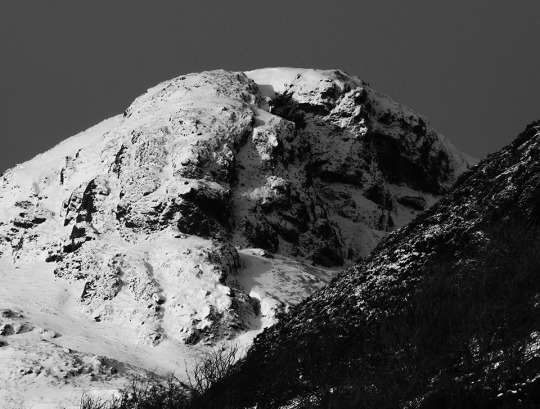
Farther along the path and with little distance to go, the lower hillside was festooned with bright yellow gorse. It flowers all year if given the chance by a mild winter, and its gaudy colour made a nice contrast set against the monochrome winter world above. A confused image to reflect a confused winter, weather-wise.
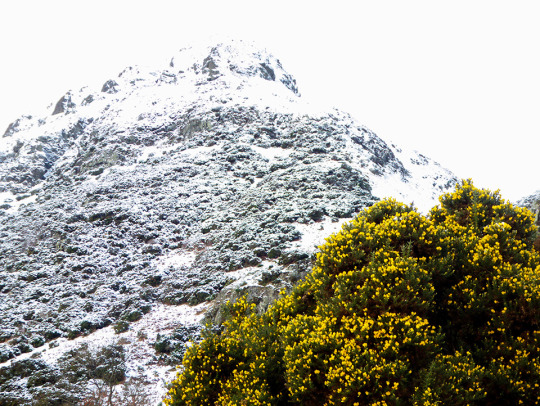
I was back at the car before lunch. The snow in and around the car park at the lower levels had already melted, so it felt good to have made the best of the stable cold conditions. I made my way back to Fife but before I left I made a point of driving a little way south so that I could get a full view back at the hill I’d just climbed. You can see Castle Law on the left, Dumyat on the right, both rising sheer in improbably fashion from the pancake below. It made for a fitting final view of what is a very big wee hill indeed!

The walk actually put me on a high that lasted a good week or so, but I also resolved to return whenever the next lasting snowfall arrives in the lowlands and a clear morning is forecast. That view of Stirling with the alpenglow burning bright is one I definitely want to see again, and I think I can safely say that my new-found enthusiasm for big wee Dum-eye-at means that any subconscious coping mechanism I may have had is no longer needed. Demons banished, I think my smile says it all :)

If you’re interested in the insane time-consuming route I took, here it is:
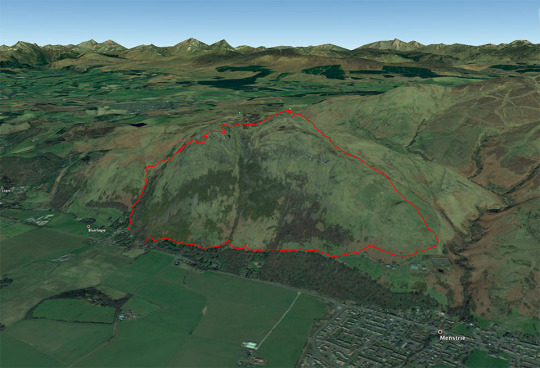
18 notes
·
View notes
Text
Tigh Grian’s Photographer (J. Schindler, director JR Partners and Trust)
Beautiful Clackmannanshire hills
Hast recovery system by Earth Save Products
The Photographer
Tour of the Alva development at Queen Street, Alva, after the inauguration’s official part at Broomhall Castle, Menstrie, Clackmannanshire
0 notes
Photo

Menstrie Castle has all the markings of a classic Scottish fortress, with its miniature turrets and solid stone walls. However, this castle was actually a cosy mansion house, built by the Alexander family in 1560 as much for comfort as defence. To learn more about our trip along the Clackmannanshire Tower Trail in Scotland, check out our latest BESPOKE travel blog post at www.tailormadeitineraries.com/blog ______________________________________ #castle #castles #castles_oftheworld #castleview #capturingbritain_castles #loves_united_castle #castillo #schloss #chateau #medievalarchitecture #discoverclacks #towertrail #nationaltrustforscotland #NTS #visitscotland #lovescotland #scotspirit #scotlandsites #somewhereinscotland #scotlandexplore #followmetoscotland #icu_scotland #thisisscotland #scotland_greatshots #scotlandtrip #scotlandroadtrip #scotlandtravel #postcardsfromtheworld #aroundtheworld #doyoutravel (at Menstrie Castle)
#discoverclacks#icu_scotland#scotlandsites#loves_united_castle#visitscotland#scotlandtravel#lovescotland#scotlandtrip#followmetoscotland#nts#nationaltrustforscotland#schloss#aroundtheworld#scotlandroadtrip#castleview#scotspirit#scotland_greatshots#scotlandexplore#capturingbritain_castles#doyoutravel#castles#thisisscotland#medievalarchitecture#towertrail#postcardsfromtheworld#castles_oftheworld#somewhereinscotland#castillo#chateau#castle
0 notes
Text

More a mansion than a fortress, Menstrie Castle dates back to 1560
#Menstrie Castle#Clackmannanshire#Stirling#Scottish castles#baronial style#William Alexander#Ochil Hills#rural Scotland
22 notes
·
View notes
Photo


December 13th 1585 saw the birth of William Drummond of Hawthornden, the noted Scottish poet.
Drummond was born at Hawthornden Castle, Midlothian, the eldest son of Sir John Drummond, Laird of Hawthornden. The Drummonds were an ancient family with connections to the Royal House of Stewart. William was educated at the High School of Edinburgh, then at Edinburgh University, graduating MA in 1605. From 1606 to 1608 he studied Law in Paris and Bourges. When he returned to Scotland in November 1608, he bought back nearly 400 volumes of French, Italian, Spanish, and English literature, the foundation of a fine private library.
In 1610, Drummond visited London, meeting some of the most famous poets of the city. Upon his father’s death later that year, Drummond became Laird of Hawthornden and retired to the family seat, to write and to lead a life of “gentlemanly simplicity”. It’s alright if you have the money eh!
Drummond has long enjoyed a reputation as Scotland’s foremost seventeenth-century poet. He wrote in English, not Scots, and is regarded as playing a major role in the Anglification of Scottish literature. As his poetic reputation grew, he began to correspond with the Scottish poets at the Court of King James VI and I: Robert Kerr, Sir Robert Aytoun, Sir David Murray, and, particularly, William Alexander of Menstrie.
When James VI made his only return to Scotland in 1617, Drummond saluted him with “Forth Feasting: A Panegyricke to the Kings Most Excellent Majestie.” This led to Drummond’s work becoming more widely known in London literary circles. Ben Jonson, on a visit to Scotland, stayed at Hawthornden Castle in 1618, and Drummond recorded their conversations. In 1623, he was deeply affected by the loss of his mother and the death of many friends in a famine that afflicted Scotland. His grief was expressed in his next volume Flowres of Sion, a collection of religious and philosophical lyrics.
In 1626, William Drummond was made a burgess of Edinburgh and in the same year made a major donation of books to Edinburgh University Library. His gift of around 550 volumes made him the Library’s first significant private benefactor and gave the Library it’s first literary collection. Drummond made further donations on an annual basis between 1628 and 1636. All in all, he presented some 800 printed titles and thirty-six manuscripts; around 700 volumes survive in the Library’s collection. These include some of the Library’s greatest treasures, especially in the fields of literature, history, geography, philosophy and theology, science, medicine and law. They include early printings of Shakespeare, Jonson, Spenser, Drayton and Sir Philip Sidney, a complete copy of John Derrick’s Image of Ireland from 1581!
By 1633, Drummond had resumed his literary career, writing a series of pageants for the Scottish coronation of Charles I. From the mid-1630s onwards, however, Drummond’s energies turned to political pamphleteering. His first overly political work was a defence of John Elphinstone, Lord Balmerino, who was convicted on a capital charge of libel against the King for possessing a document thought to be treasonable.
He also got involved with The National Covenant, although opposed to the infamous prayer book, rather than the taking of arms which blighted Scottish history he advocated passive obedience to the King. Further pamphlets attacked the Presbyterian grip on the country and warned of the consequences of civil war.
Drummond played no personal role in the Bishops’ Wars of 1639 and 1640, and in the civil conflicts that rocked England and Scotland over the following decade. His last substantial tract was Skiamachia, or, A Defence of a Petition in 1643, in which he assumed an extreme anti-clerical position.
Drummond died at Hawthornden Castle on 4th December 1649, his son William and brother-in-law collaborated with the posthumous printing of much of Drummond’s work.
The wooded solitude Drummond enjoyed at Hawthornden still exists to this day and is an international retreat for writers at Hawthornden Castle has been founded to provide a peaceful setting where creative writers can work without disturbance. To me though, below the cliff it sits on above the River Esk, is the interesting bit, Wallace’s Cave, a large rock cavern with a neatly chiseled doorway said to be where our favourite Freedom fighter used at the time of the Battle of Roslin, which took place nearby in 1303.
To The Nightingale
Sweet bird, that sing'st away the early hours Of winters past or coming, void of care, Well pleased with delights which present are, (Fair seasons, budding sprays, sweet-smelling flowers) To rocks, to springs, to rills, from leafy bowers Thou thy Creator's goodness dost declare, And what dear gifts on thee He did not spare: A stain to human sense in sin that lours, What soul can be so sick which by thy songs (Attired in sweetness) sweetly is not driven Quite to forget earth's turmoils, spites, and wrongs, And lift a reverend eye and thought to heaven? Sweet artless songster, thou my mind dost raise To airs of spheres, yes, and to angels' lays.
33 notes
·
View notes
Photo

December 13th 1585 saw the birth of William Drummond of Hawthornden, the noted Scottish poet.
Drummond was born at Hawthornden Castle, near Bonnyrigg, Midlothian, the eldest son of Sir John Drummond, Laird of Hawthornden. The Drummonds were an ancient family with connections to the Royal House of Stewart. Drummond was educated at the High School of Edinburgh, then at Edinburgh University, graduating MA in 1605. From 1606 to 1608 he studied Law in Paris and Bourges. When he returned to Scotland in November 1608, he bought back nearly 400 volumes of French, Italian, Spanish, and English literature, the foundation of a fine private library. In 1610, Drummond visited London, meeting some of the most famous poets of the city. Upon his father’s death later that year, Drummond became Laird of Hawthornden and retired to the family seat, to write and to lead a life of "gentlemanly simplicity". It's alright if you have the money eh!
Drummond has long enjoyed a reputation as Scotland’s foremost seventeenth-century poet. He wrote in English, not Scots, and is regarded as playing a major role in the Anglification of Scottish literature. As his poetic reputation grew, he began to correspond with the Scottish poets at the Court of King James VI and I: Robert Kerr, Sir Robert Aytoun, Sir David Murray, and, particularly, William Alexander of Menstrie.
When James VI made his only return to Scotland in 1617, Drummond saluted him with Forth Feasting: A Panegyricke to the Kings Most Excellent Majestie. This led to Drummond’s work becoming more widely known in London literary circles. Ben Jonson, on a visit to Scotland, stayed at Hawthornden Castle in 1618, and Drummond recorded their conversations. In 1623, Drummond was deeply affected by the loss of his mother and the death of many friends in a famine that afflicted Scotland. His grief was expressed in his next volume Flowres of Sion, a collection of religious and philosophical lyrics.
In 1626, Drummond was made a burgess of Edinburgh and in the same year made a major donation of books to Edinburgh University Library. His gift of around 550 volumes made him the Library's first significant private benefactor and gave the Library it's first literary collection. Drummond made further donations on an annual basis between 1628 and 1636. All in all, he presented some 800 printed titles and thirty-six manuscripts; around 700 volumes survive in the Library’s collection. These include some of the Library's greatest treasures, especially in the fields of literature, history, geography, philosophy and theology, science, medicine and law. They include early printings of Shakespeare, Jonson, Spenser, Drayton and Sir Philip Sidney, a complete copy of John Derrick's Image of Irelande from 1581!
By 1633, Drummond had resumed his literary career, writing a series of pageants for the Scottish coronation of Charles I. From the mid-1630s onwards, however, Drummond’s energies turned to political pamphleteering. His first overly political work was a defence of John Elphinstone, Lord Balmerino, who was convicted on a capital charge of libel against the King for possessing a document thought to be treasonable.
He also got involved with The National Covenant, although opposed to the infamous prayer book, rather than the taking of arms which blighted Scottish history he advocated passive obedience to the King. Further pamphlets attacked the Presbyterian grip on the country and warned of the consequences of civil war.
Drummond played no personal role in the Bishops’ Wars of 1639 and 1640, and in the civil conflicts that rocked England and Scotland over the following decade. His last substantial tract was Skiamachia, or, A Defence of a Petition in 1643, in which he assumed an extreme anti-clerical position.
Drummond died at Hawthornden Castle on 4 December 1649. Drummond’s son William and brother-in-law collaborated the posthumous printing of much of Drummond’s work.
The wooded solitude Drummond enjoyed at Hawthornden still exists to this day and is an international retreat for writers at Hawthornden Castle has been founded to provide a peaceful setting where creative writers can work without disturbance. To me though, below the cliff it sits on above the River Esk, is the interesting bit, Wallace's Cave, a large rock cavern with a neatly chiseled doorway said to be where our favourite Freedom fighter used at the time of the Battle of Roslin, which took place nearby in 1303.
13 notes
·
View notes
Photo





Menstrie Castle
My Tumblr friend from Oregon @beachgirlnikita was over visiting again, her third visit in just over a year, I worked out a few places to see within easy reach of Falkirk, first stop was this place.
Menstrie Castle is not what you would expect from a castle, for one it’s in the midst of a housing scheme and two most of it has been subdivided into flats. The ground floor to the left of the frontage is a museum and the only part accessible to the public, unfortunately the info I read beforehand turned out to be incorrect and it was closed when we popped by.
Sir William Alexander, 1st Earl of Stirling, was born here in 1567. He was James VI’s Lieutenant for the plantation of Nova Scotia and a noted poet. The earliest date given for the existence of "Menstrie Castle" is 1322 when in the ownership of Dougal Campbell a member of the Campbell of Argyle family. The building was a favourite dwelling place of the Earls of Argyle until 1526 when title was transferred to the family of Alexander of Menstrie.
Okay it’s not really a castle, as such, but it has obviously changed much over the years, I can imagine it being more of a defensive building during the 14th century although with the area being in a relatively flat part of Clackmannanshire I can’t see it ever having been much of a keep. It’s often described as a baronial Mansion House and whereas people might not agree with it being made into “flats” the alternative was demolition as the building was derelict and was close to being pulled down in the 1950′s.
Whatever you think of Menstrie castle it’s a curious place and and well worth a look at, I especially love the wee turrets visible in the second pic.
34 notes
·
View notes
Text
Invitation from Link and Paragon Housing Associations at Broomhill Castle, Menstrie, withMisinter for LOcak Government and Housing, Kevin Stuart, MSP and tour of the development at Queen Street, Alva.
Alva Academy- Invite
Official Inauguration of Alva development Tuesday, March 13, 2018 Invitation from Link and Paragon Housing Associations at Broomhill Castle, Menstrie, withMisinter for LOcak Government and Housing, Kevin Stuart, MSP and tour of the development at Queen Street, Alva. Alva Academy- Invite
0 notes
Text
My mother and I used to go on long walks in the English countryside. We would fill our backpacks with pyjamas and shampoo and stroll around, feeling desperately at one with nature. We haven’t been recently, since my mum has concerns about her knees and general stamina, but on our recent trip to Scotland I had one major focus: we were going to walk up a hill.
We thought that maybe we would ask the hotel for suggestions but, then, I chanced upon an ordinance survey map. I’d been looking for one for our specific area of Scotland, and I’d found it. OS map in hand, we planned our own route. Mother thought we were being ambitious, but I knew it would all be ok.
Kit
Each of us wore:
long puffa coat
woolly hat/gloves/scarf
leggings/top/jumper
woolly socks
proper walking shoes
We took with us:
OS map
water
grapes
bread/ham/cheese (for sandwiches at lunch!)
first aid kit
emergency blankets (those silver ones trauma survivors get)
camera (including my new wide angle lens, for awesome landscape photography)
phones
And now, ladies and gentlemen, allow me to present…
Our one-day circular walk in the Ochill Hills
We started at Broomhill Castle and went up the west-side of the Menstrie Glen. We followed the footpath to the Lossburn Reservoir, and beyond to the main road. We then headed back south down the main road, before heading back east at the ‘sheep pens’. After the ford, we went up both hills – to the memorial and then to Castle Law – before going back down to Blairlogie, and along the footpath behind the houses to Menstrie. It took about 6 hours, including around 1 hour of breaks and a teeny weeny bit of getting lost!
We headed out at dawn! Ok, more like 9.45am but still… the fog looked quite heavy up on the hills, but we were sure it was just morning weather.
The first climb was a little steep, but looking back over that first hill was very exciting and satisfying. After that it was much easier, along a nice gravel track.
The fog was still quite heavy, which is why we didn’t notice a herd of highland cattle. They were so still and silent we thought for a moment that they were statutes – some sort of weird art installation in the middle of the Highlands. We were a little scared of them, so we didn’t take any photos until we were well clear. I really like the shot I got though.
After that, more walking, more fog. It was really very beautiful, I promise! Even if the photos make it seem a little bland. After the Lossburn Reservoir we got to the main road and were very concerned about whether we would notice the turn back onto the footpath…
Fortunately, there was something of a carpark! It seems as though the two hills we’d chosen to walk up were a bit of an attraction. It was certainly very lovely to finally rise out of the fog – as we got higher and higher the air got clearer and the colours got brighter and brighter.
At one point we thought we were choosing between the two peaks, and decided to avoid the ramblers and go up the easier hill. Fortunately, we’d made a mistake and actually decided to go up the taller hill and, I mean, well…
…look at this view! It was really incredible and worth all of the sweat and effort. It was only 1pm or so at this point so we sat down to eat our sandwiches. We found a little nook on the side of the hill that was protected from the wind. It meant we were looking down the valley and, as the clouds shifted, we should see sheep on the slopes below.
After lunch we got a little chilly from all of that sitting down, so we decided to take on the second hill. It was very easy (because we were such champion walkers by now) although the path wasn’t so clear. We ended up cutting through a bog, and my feet got a little wet.
In fact, this was the start of quite a lot of getting lost. On reflection we were very tired and weren’t trying so hard on following the map. We wandered around for a little while, and eventually made it back to the main road. After that, we chose to follow the road rather than go back up into the hills to get back to Menstrie. What can I say, we were tired! If you want to take the scenic (i.e. hilly) route back, just follow the signs to the ‘high road to Menstrie’.
Once we got back to the hotel, we took a well deserved bath (each, not together!) and ate an exceptionally large amount of food. In short, a perfect day.
My mother and I used to go on long walks in the English countryside. My mother and I used to go on long walks in the English countryside. We would fill our backpacks with pyjamas and shampoo and stroll around, feeling desperately at one with nature.
0 notes